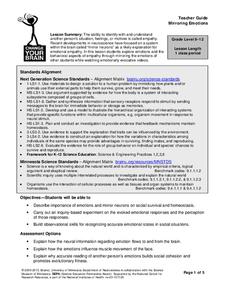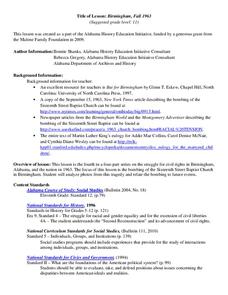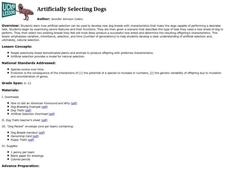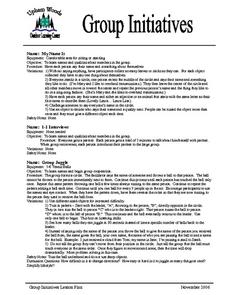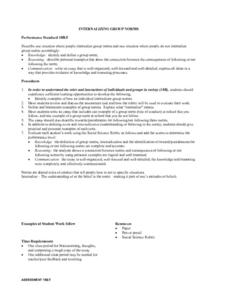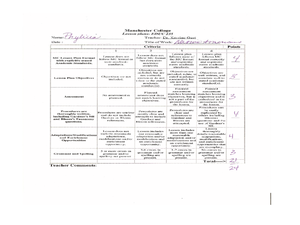NOAA
Watch the Screen!
Can a sponge cure cancer? Life science pupils visit the drugstore under the sea in the fifth lesson of six. Working groups research the topic then get hands-on experience by testing the inhibiting effects of several plant extracts...
NOAA
Stressed Out!
Are our oceans really suffering due to the choices humans make? The sixth and final installment in the volume of activities challenges research groups to tackle one of six major topics that impact ocean health. After getting to the...
US Institute of Peace
Identifying Conflict Styles
Are you a peace-keeper or a problem-solver? Explore conflict management styles through a lesson, fourth in a 15-part series, that combines individual assessment and collaborative work. Groups learn the basic tendencies of each style,...
Roy Rosenzweig Center for History and New Media
Continental Differences
Students break into groups and closely investigate primary sources associated with the seven different continents. After deciding which continent their primary sources relate to, representatives from each group present their...
NOAA
What's the Big Deal?
Who knew that a possible answer to Earth's energy resource problems was lurking deep beneath the ocean's surface? Part four of a six-part series introduces Earth Science pupils to methane hydrate, a waste product of methanogens. After...
University of Minnesota
Mirroring Emotions
Do you ever give your class the "teacher look"? Without saying a word, they become silent and engaged (hopefully). How do they know what you're thinking? Explore the concept of nonverbal communication and how it relates to our...
University of Arkansas
Our Responsibilities
The fourth in a five-lesson unit examining human rights and personal responsibility asks class groups to investigate a current rights issue, and using the provided graphic organizer, summarize the issue, consider which rights are being...
Curated OER
Seeing the Image in Imagery: A Lesson Plan Using Film
In our increasingly visual society, it is often difficult for some readers to create a mental picture of a picture created only with words. An image-rich text like F. Scott Fitzgerald's The Great Gatsby can therefore, present a real...
Alabama Department of Archives and History
Birmingham, Fall 1963
Can any good come from acts of evil? The 1963 bombing of the Sixteenth Street Baptist Church in Birmingham, Alabama, and the eventual outcomes of the tragedy, are the focus of a lesson that asks groups to examine primary source documents...
University of California
Artificially Selecting Dogs
Selective breeding has resulted in some novel and beautiful or useful dogs over the years. Using the American Foxhound as an example, genetics learners find out how and why they came about. Then, in small groups, they select breeds to...
American Chemical Society
Protons, Neutrons, and Electrons
Atomic bombs harness the power in the nucleus of an atom, creating devastating power and damage. Classes review parts of an atom by charging a piece of plastic and holding it near their fingers, discussing what is happening and why....
Smithsonian Institution
Two Perspectives on the Battle of Little Bighorn/Greasy Grass
Learners understand why historians conduct research and the importance of perception when it comes to studying history. The resource covers The Wars of Expansion and the Battle of Little Bighorn/Greasy Grass through group work, debate,...
Federal Reserve Bank
Turn Your Radio On
After listening to and analyzing a series of FDR's Fireside Chats, groups create their own recordings, and using New Deal programs, address a current economic condition.
Anti-Defamation League
Identity-Based Bullying
What is identity? What is bullying? What is identity-based bullying? After discussing these questions as a class, pupils engage in partner discussions before participating in a small group activity to act out bullying scenarios. Then,...
California Academy of Science
Optimal and Sustainable: Renewable Energy Revamp
More than 100 cities around the world have shifted from fossil fuels to renewable energy sources. Scholars investigate a city wanting to make this switch, but needs help determining how to make the shift. Groups consider all options,...
US Department of Agriculture
Serving Up My Plate
Offer your youngsters an extra helping of nutritional knowledge and healthy tips with this resource, which centers around the MyPlate nutritional guide and offers three "courses" of plans and worksheets on the food groups and the...
Novelinks
Count of Monte Cristo: Professor Know‐It‐All
Kids love to be the experts! With four themes from The Count of Monte Cristo by Alexandre Dumas, small groups work together to answer specific questions addressing each theme. They then stand in front of the class and field...
Curated OER
Group Initiatives
Students explore the names and qualities about members in the group. They each say their name and something about themselves. Students gather around in a circle. They listen to the teacher as he or she says the name of someone and throws...
Curated OER
Group Dynamics
Middle schoolers define the purpose of different groups. Using photographs, they practice identifying the group affiliation to one another and describe their characteristics in the picture. They discover the similarities and differences...
Curated OER
Working in Small Groups
Students learn the advantages of working in small groups and how it is a lifetime skill. They learn that each member has responsibility to contribute to the plan of the group. They then learn group cooperation rules.
Curated OER
Folk Groups and Community Folklife
Students explore folk groups and traditions in their local community. In this folklife lesson plan, students list the folk groups they belong to and its traditions. Students write about their favorite tradition and may complete extension...
Curated OER
Internalizing Group Norms
Young scholars consider how to internalize group norms. They descirbe a situation where people internalize group norms and a situation where people do not internalize group norms. They brainstorm examples of group norms and define...
Curated OER
Other Native American Groups
Fourth graders identify the three Native American groups highlighted in this lesson. In this Native American lesson plan, 4th graders answer comprehension questions, and classify the adaptations of the groups in a worksheet.
Curated OER
Food Group Craze
Students play a game to learn or reinforce prior learning of the food groups within the food guide pryamid.
Other popular searches
- Food Groups
- Ethnic Groups
- Cooperative Groups
- Interest Groups
- Ethnic and Minority Groups
- Pe Games Large Groups
- Five Basic Food Groups
- Five Food Groups
- Major Muscle Groups
- Esl Lessons Food Groups
- Four Basic Food Groups
- Clip Art Food Groups





